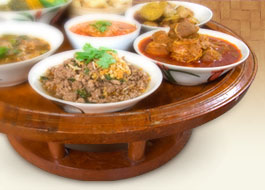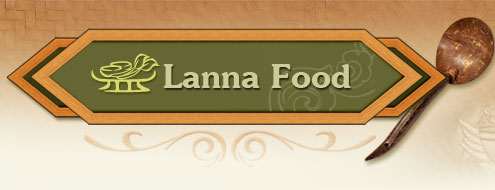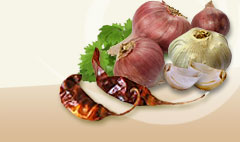Mint leaves |
|
|
 | Mentha cordifolia |
|
| |
 | Labiatae |
|
| |
 | Kitchen mint |
|
| |
 | Hom duan, phak duan (Northern) (Rattana Phromphichai, 1999, p. 7527), sara nae suan (Central) (Phennapha Sapcharoen and Kanchana Diwiset, eds., 1999, p. 214) |
|
| |
 | Perennial, creeping herb, covered with short hair, fragrant stems. Leaves alternate opposite, short stem. Leaves ovate, obtuse, serrate, undulate, fragrant. (Phennapha Sapcharoen and Kanchana Diwiset, eds., 1999, p. 214) |
|
| |
 |

Protein, carbohydrates, calcium, phosphorus, iron, vitamin C, thiamin, niacin, rybloflavin. (Phak Phuen Ban Ahan Pheun Mueang, 2007, p. 82)
Food: Lanna people use it to enhance the flavor of food like tam ba khluea, yam chi kai,, yam kop or eaten raw with namphrik and yam. (Rattana Phromphichai, 1999, p. 7527) It is eaten with namphrik as a raw vegetable and put in phla, yam to improve the taste as well as the odor. Sometimes the leaves are deep fried to add to khao mok kai or khao mok phai. (Phennapha Sapcharoen and Kanchana Diwiset, eds., 1999 , p. 214)
|

Leaves induce sweating, used as an anti-asthma, anti-stomachache, to treat intestinal stuffiness, muscle spasms, as well as a poultice to reduce swelling. (Phennapha Sapcharoen and Kanchana Diwiset, eds., 1999, p. 214) |
|
| |
 | All year round |
|
| |
 |
Phak Phuen Ban Ahan Phuen Mueang. (2007). Bangkok: Fa Aphai Co., Ltd. Phennapha Sapcharoen and Kanchana Diwiset, eds. (1999). Mai Rim Rua: Samunphrai Kap Wattanatham Thai, Part 2. Nonthaburi: Institute of Traditional Thai Medicine. Rattana Phromphichai. (1999). Hom Duan. in Saranukrom Wattanatham Thai Pak Nuea (Vol. 14, p. 7527). Bangkok: Siam Commercial Bank Foundation for the Encyclopedia of Thai Culture. |
|
| |
|
|




